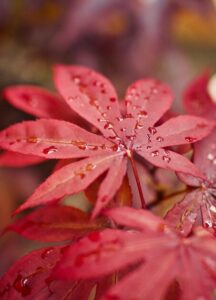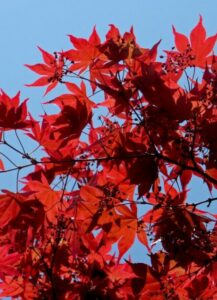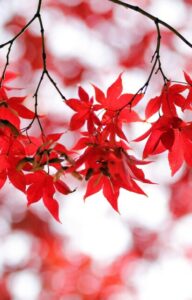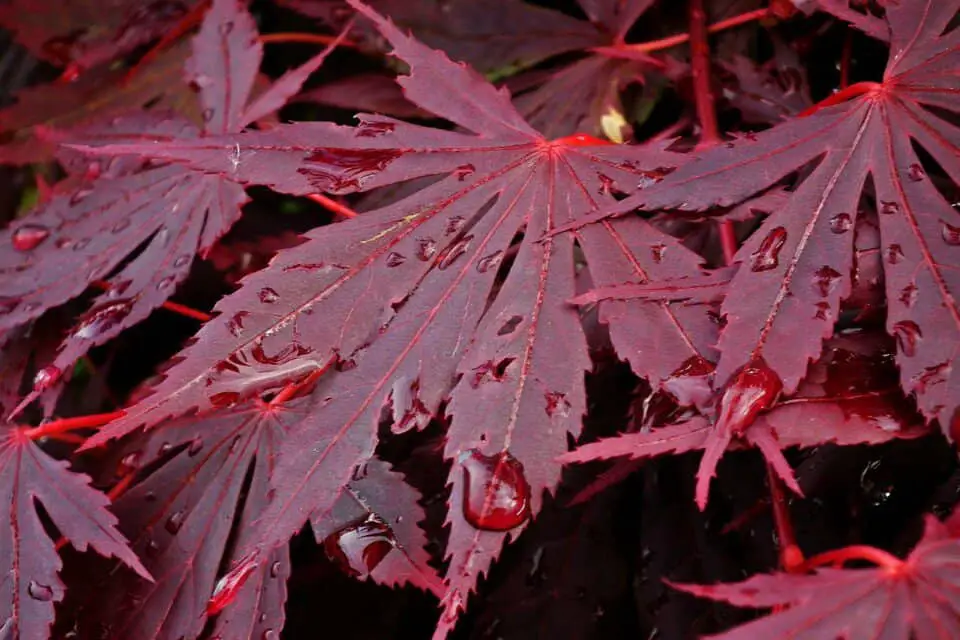Some links in the post are affiliate links and I get a commission from purchases made through some links found in the post.
Maples are a highly sought-after species for landscaping designs. They augur so well with the vibe and are quite breath-taking in the fall when their leaves change their hues to red, orange, yellow, and even purple!
But while these trees are genuinely awe-inspiring, you can’t have them all in your garden. To start with, they grow in different zones and need different elements to reach their optimal heights.
Sadly, we must choose which species to keep and which one we can admire in magazines. This guide takes you through what the Japanese and red maples have in common and what to consider before adding each to your garden.
Japanese maples and red maples both flower, prefer lower pH levels and rarely need pruning. They differ with their light requirements, natural habitats, sizes and soil needs.
Hopefully, your decision will be clearer and easier in the end. Let’s start dissecting the facts, shall we?
Japanese Maple Vs Red Maple – What Are the Similarities?
 Let’s start with an easy one – they are both maples. Did you see that coming? Of course, you did, and it probably had a lot to do with why you’re comparing these species.
Let’s start with an easy one – they are both maples. Did you see that coming? Of course, you did, and it probably had a lot to do with why you’re comparing these species.
Maples are trees that belong to the family Sapindaceae and the genus Acer. And there are more than 100 species you can choose from. How great is that?
They all have beautiful displays in the fall when their leaves take on other hues. As the name suggests, the red maple takes on a red, orange, or yellow hue in the fall.
And the Japanese maple takes on similar colors and can even take on purple hues! Thus, regardless of which maple you choose, you still enjoy a color change in the fall.
What other similarities do these trees have?
1) They Flower
The red maple blooms in the spring, producing small and red flowers. Interestingly, the red hue does not disappear after the flowers have developed into fruits.
Instead, it exhibits in the leaves in the fall. And once the leaves fall off, the stems take on a reddish hue, enabling you to enjoy the façade a while longer.
Come spring, you get to enjoy the flowers once again. That is a year-long exhibition which you enjoy for free if you give the plant what it needs.
How about the Japanese maple? This beauty also flowers in the spring, producing small red or purple flowers. Over time, these develop into a dry-winged fruit that measures half an inch.
You may also like: Where should you plant a Japanese maple tree
2) They Prefer Lower pH Levels
Both maples like slightly acidic soils with a pH range between 4.5 and 6.5. They can tolerate neutral soil conditions but will not do well in alkaline soils.
Alkaline conditions trigger chlorosis, barring the trees from photosynthesizing and thus interfering with their growth.
The trees would rather be in acidic conditions and can withstand levels as low as 3.7. But once you get to the 7.3 mark, the tree’s leaves start paling as photosynthesis suffers a dip.
3) They Rarely Need Pruning
Most gardeners like pruning their trees to eliminate diseased parts, encourage new growth, and even shape the trees. With maple trees, pruning can take a back seat.
Take the Japanese maple, for example. It is a slow-grower that averages about 15 feet (4.5 meters). Pruning is only necessary if you want to improve its appearance and make it align with the landscape.
For example, you can prune it to encourage the growth of other trunks, so it looks like more of a shrub than a tree. The same holds for the red maple, which is highly sensitive to pruning.
Only prune these trees when necessary. Otherwise, allow them to grow as they would in the wild, reducing their exposure to pests and diseases.
Oh, and they also have minimal fertilizer needs. In most cases, they can feed on mulch, dead leaves, and other organic matter without showing signs of nutrition deficiency.
You may also like: 6 reasons your acer tree is dying & how to fix it
Japanese Maple Vs. Red Maple – What Are the Differences?
They are both maples. What could be so different about them? The answer is – a lot! Please look at factors to consider when buying any of these maples:
1) The Light Requirements
 The light requirements for these maples are similar yet different. How so? They can both withstand partial shade – this is light exposure to the morning sun for at least four hours a day.
The light requirements for these maples are similar yet different. How so? They can both withstand partial shade – this is light exposure to the morning sun for at least four hours a day.
It is unlike partial sun, which can feature either morning or afternoon sun.
However, the red maple can also do well in the full sun. That is bright and direct light from the sun, devoid of barriers.
Under such light, the tree makes enough food to support healthy growth and blooming. It does best in such light and tolerates partial shade.
And if placed in partial shade in the cooler zones, its growth stunts, and the tree becomes more exposed to root rot.
But the Japanese maple is quite different. Rather than tolerate partial shade, it thrives in it. Moreover, it does well in dappled/ filtered light which is bright and indirect light.
The photons from such exposure are enough to support photosynthesis. When placed in full sun, the Japanese maple suffers sunburn, which damages its leaves and hurts its growth.
Thus, when growing the trees, you must consider how much light you can afford them.
You may also like: Why is my Japanese maple turning brown & how to fix it
2) Their Natural Habitats
A plant’s home plays a vital role in how well it adapts to your climate. So, where do these maple trees come from, and where can you grow them?
- Japanese maples come from Japan, Korea, China, and regions in Russia and Mongolia. These trees can grow in hardiness zones 5 to 9. However, zone 5 is only ideal for red varieties. When growing green-leafed Japanese maples, aim for hotter and drier regions as these are more similar to their habitats. Additionally, these trees do not do well when exposed to strong winds. Plant them near shade or install barriers to keep them from suffering damage owing to the drafts.
- Red maples are native to the Eastern American deciduous forest. They do well in USDA zones 3 to 9. These trees are more adaptable than the Japanese maples, hence their varied USDA zones. You can grow them in hot and dry climates, and they would do equally well in colder regions.
Thus, red maples are more suited to colder weather and can withstand winters where the frost is not too much.
They can also grow in hotter regions where the Japanese maple would otherwise have a hard time establishing. If you live in an area with extreme conditions, choosing the red maple would be the better choice.
3) Their Sizes
Are these trees similar in size? Not even close. The red maple is the more avid grower, which can reach 70 feet (21 meters) tall with a diameter of up to 50 feet (15 meters).
Whoa! That makes it excellent for use as a shade tree under which you can grow veggies, host picnics, or even contrast your landscaping design.
It has a relatively low canopy, and if you’re planting it outdoors, you should only position it in a site where height will not be an issue.
Else, the tree’s growth can get out of hand. However, this does not mean that you cannot grow it indoors. You can successfully cultivate it in a pot if you keep pruning it to curb its height at two feet so you can control the growth of its roots.
The Japanese maple is the much smaller variety with a mature height of 25 feet (7.5 meters) and a spread close to 8 meters.
Its small size makes it a perfect addition to any yard where space is a concern. Plus, it is a slow-growing species that will not take over your garden at once. On average, most species do not even grow past 15 feet (4.5 meters).
Besides, you can always prune it to control how far it reaches. It also grows indoors quite well if you can supplement the natural light with effective artificial lights.
People with small yards can consider the Japanese maple, while those who want a showy tree can always go for the red maple.
You may also like: 6 benefits of a owning a Japanese maple
4) Their Soil Needs
Japanese maples prefer being in moist and well-draining soil and do not do well in soggy soils. If anything, being in waterlogged soils predisposes them to root rot and could kill them.
The best option is to use loamy soil as it has a medium texture and moderate water retention capacity. Does this mean the plant can go long without water?
Not quite – your Japanese maple prefers regular watering to keep the soil moist so it can absorb enough for photosynthesis.
It should not be in dry soil for too long, and you should thus supplement rainwater with additional watering when necessary.
Is this the case with the red maple? It is actually quite different. This tree can tolerate different soil textures and can even grow in sandy and clay soils.
As such, it can do well in moist and dry soils. But it draws the line at salty soils and waterlogged soils. Ensure you water the soil adequately to keep it from drying completely.
If you prefer to plant a tree without amending the soil, the red maple is a good choice. Anyone growing the Japanese maple must amend the soil to ensure its drainage and retention are similar to keep overwatering at bay.
Final Thoughts
 Who thought that trees in the same family could be worlds apart? But they are. While these trees are maples, their differences outweigh their similarities.
Who thought that trees in the same family could be worlds apart? But they are. While these trees are maples, their differences outweigh their similarities.
Thus, planting both species in your garden would be difficult. It’s best to choose which tree best fits your landscaping design and go with it.
Before you go, here are some more related articles I encourage you to read below to help solve more of your gardening issues:
What are the Common Red Maple Problems
Why is Your Red Maple Turning Green
Why is Your Red Maple Turning Brown
What are the Common Bloodgood Japanese Maple Tree Problems
Why is your Japanese Maple Turning Green
Happy Gardening!


